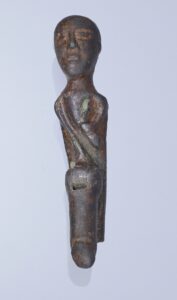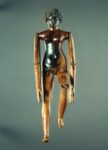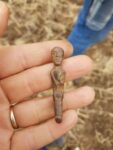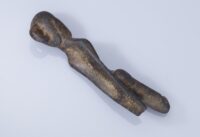 The latest entry in the ancient phallus sweepstakes brings something new to the table: a hinge at the base of the penis that gives it articulating erection action. G.I. Joe is chartreuse with envy right now. The bronze figurine of a male with a disproportionately prodigious hinged phallus was discovered in Haconby, Lincolnshire. It dates to the 1st century A.D. It is the only Iron Age posable phallus ever discovered.
The latest entry in the ancient phallus sweepstakes brings something new to the table: a hinge at the base of the penis that gives it articulating erection action. G.I. Joe is chartreuse with envy right now. The bronze figurine of a male with a disproportionately prodigious hinged phallus was discovered in Haconby, Lincolnshire. It dates to the 1st century A.D. It is the only Iron Age posable phallus ever discovered.
The bronze figure is a petite 5.5 cm (2.2 inches) high and 1.2 cm (.5 inches) wide. It is the stylized figure a man with an oval face, flat nose and slit mouth. His left arm is bent and holding a small bag against his chest. His right arm extends down his torso to clutch what is by far the largest part of him. So large, in fact, that when it is in its flaccid posture it is significantly longer than his short conjoined legs. A loop behind his head suggests it was meant to be worn as a pendant.
That this is the first hinged phallus figure we know of from antiquity is really saying something when you consider the sheer scale of phallus production in the Greco-Roman world. Obviously Roman metal smiths and wood carvers had the know-how for this kind of articulation. The exceptional doll found in the  sarcophagus of a young Roman woman of the 2nd century named Crepereia Tryphaena has fully movable hip, knee and elbow joints. They just don’t seem to have employed the technique in their phallocrafting.
sarcophagus of a young Roman woman of the 2nd century named Crepereia Tryphaena has fully movable hip, knee and elbow joints. They just don’t seem to have employed the technique in their phallocrafting.
The figurine was discovered by Paul Shepheard who was participating in a metal detecting rally alongside his wife Joanne. She found a medieval penny. He found a Celtic bronze nude with an articulating penis. He didn’t immediately recognize it as such, perhaps unsurprisingly. As a former farm equipment restorer, Paul thought it looked like a split pin, a part used to  fix wheels on carts. Then he saw it had a face and realized it was a figure, not a pin.
fix wheels on carts. Then he saw it had a face and realized it was a figure, not a pin.
The Haconby Celtic fertility figurine will be going under the hammer at Noonan’s Ancient Coins and Antiquities auction on March 9th. The pre-sale estimate is £800 to 1,200 ($965-1,447).
In other recent phallus news, The Guardian published a letter proposing that the wooden one from Vindolanda is a lot closer to a darning tool than a phallus after all. Linsey Duncan-Pitt of Telford, Shropshire, makes a persuasive (and highly entertaining) argument that it was a drop spindle.
The tip looks a little glans-like, but it is also like the notch at the pointed end of the dealgan, used to secure the spun fibre with a half-hitch. The spindle is then rotated to add twist to the drafted fibres, and the spun fibre is wound around the shaft. The base of the artefact is wider than the tapering shaft; that would help stop the fibre slipping off. Some dealgans have a notch on the base, but not all.
Given that it was found among other crafting materials, this would seem to be a much more feasible explanation for this object than a dildo. It’s a bit understated as a dildo, and would no doubt make for a more satisfying spin than anything else.
Modern spinners like me love a decorative and unusual spindle, and so it seems more logical that this was a cheeky Roman design.


